Apple A1349, MC676LL-A, A1442, A1429, A1431 User Manual
...
iPhone User’s Guide

1 Contents
Chapter 1 |
5 |
Activating and Setting Up iPhone |
|
5 |
What You Need |
|
5 |
Activating iPhone |
|
7 |
Syncing iPhone with Your Computer |
|
11 |
Disconnecting iPhone from Your Computer |
Chapter 2 |
12 |
Basics |
|
12 |
iPhone at a Glance |
|
14 |
Home Screen |
|
17 |
iPhone Buttons and Touchscreen |
|
23 |
Using the Stereo Headset |
|
24 |
Connecting to the Internet |
|
26 |
Using iPhone on an Airplane |
|
27 |
Charging the Battery |
|
28 |
Cleaning iPhone |
Chapter 3 |
29 |
Phone |
|
29 |
Calling and Answering |
|
34 |
Visual Voicemail |
|
37 |
Adding Contact Information to iPhone |
|
40 |
Ringtones |
|
41 |
Using iPhone with a Bluetooth Headset or Car Kit |
|
44 |
Calling to and from Other Countries |
|
45 |
Phone Settings |
Chapter 4 |
46 |
|
|
46 |
Setting Up Email Accounts |
|
48 |
Sending Email |
|
49 |
Checking and Reading Email |
|
51 |
Mail Settings |
2
Chapter 5 |
52 |
Safari |
|
52 |
Surfing the Web |
|
56 |
Adding Safari Web Clips to the Home Screen |
|
56 |
Using Bookmarks |
|
57 |
Safari Settings |
Chapter 6 |
58 |
iPod |
|
58 |
Syncing iPod Content from Your iTunes Library |
|
59 |
Playing Music |
|
64 |
Watching Videos |
|
67 |
iPod Settings |
Chapter 7 |
68 |
Applications |
|
68 |
Text |
|
70 |
Calendar |
|
73 |
Photos and Camera |
|
77 |
YouTube |
|
80 |
Stocks |
|
81 |
Maps |
|
86 |
Weather |
|
87 |
Clock |
|
89 |
Calculator |
|
90 |
Notes |
Chapter 8 |
91 |
Settings |
|
91 |
Airplane Mode |
|
92 |
Wi-Fi |
|
93 |
Carrier |
|
93 |
Usage |
|
93 |
Sounds and the Ring/Silent Switch |
|
94 |
Brightness |
|
95 |
Wallpaper |
|
95 |
General |
|
99 |
|
|
101 |
Phone |
|
103 |
Safari |
|
104 |
iPod |
|
106 |
Photos |
|
106 |
Restoring or Transferring Your iPhone Settings |
Contents |
3 |
|
|
Chapter 9 |
108 |
iTunes Wi-Fi Music Store |
|
109 |
Browsing and Searching |
|
111 |
Purchasing Songs and Albums |
|
112 |
Syncing Purchased Content |
|
113 |
Verifying purchases |
|
113 |
Changing Your iTunes Store Account Information |
Appendix A |
114 |
Tips and Troubleshooting |
|
114 |
General Suggestions |
|
119 |
Removing the SIM Card |
|
120 |
Updating and Restoring iPhone Software |
|
120 |
Using iPhone Accessibility Features |
Appendix B |
122 |
Learning More, Service, and Support |
Index |
124 |
|
4 |
Contents |
|
|

1 Activating and Setting Up iPhone 1
·To avoid injury, read all operating instructions in this guide and safety information in the Important Product Information Guide at www.apple.com/
support/manuals/iphone before using iPhone.
What You Need
To use iPhone, you need:
ÂA new wireless service plan with the carrier that provides iPhone service in your area
ÂA Mac or a PC with a USB 2.0 port and one of the following operating systems:
ÂMac OS X version10.4.10 or later
ÂWindows XP Home or Professional with Service Pack 2 or later
ÂWindows Vista Home Premium, Business, Enterprise, or Ultimate edition
ÂDisplay resolution on your computer set to 1024 x 768 or higher
ÂiTunes 7.5 or later, available at www.apple.com/itunes
ÂAn iTunes Store account (a major credit card is required to open a new account)
ÂAn Internet connection
Activating iPhone
Before you can use any of iPhone’s features, you must activate iPhone by signing up for a service plan with the iPhone service carrier in your area and registering iPhone with the network. If you already have a wireless account with the carrier, you may be able to upgrade your account to work with iPhone, or keep using your old phone and add a new line for iPhone. (Some accounts may not be upgradable.) You may also be able to transfer your current phone number to iPhone, or get a new one.
For more information about iPhone, including videos about how to activate and use it, go to:
www.apple.com/iphone
5

Inserting the iPhone SIM Card
In some regions, you may need to purchase the SIM card separately and insert it into iPhone before activation. Read the documentation that comes with the SIM card for instructions.
If your carrier gave you a PIN number to use with your SIM, you may need to enter the PIN before activating iPhone.
Activate iPhone
1 Download and install the latest version of iTunes from www.apple.com/itunes.
2Connect iPhone to a USB 2.0 port on your Mac or PC using the dock and cable that came with iPhone.
Unless your keyboard has a high-powered USB 2.0 port, you must connect iPhone to a USB 2.0 port on your computer.
3Follow the onscreen instructions in iTunes to activate iPhone and sync iPhone with your contacts, calendars, email accounts, and bookmarks on your computer.
A single checkmark in “Set Up Your iPhone” syncs all these items automatically. Or you can use iTunes to customize the information you sync, and to sync your ringtones, music, photos, podcasts, and videos to iPhone. See the following section.
You can disconnect iPhone from your computer after “Waiting for activation” appears on the iPhone screen. When activation is complete,“iPhone is activated” appears on the iPhone screen. This means that iPhone is fully functional and you can use all of its features.
Important: If you are migrating your current phone number to iPhone, activation may take from several hours to a day and migration of your number may take several days, depending on your location and previous carrier.
6 |
Chapter 1 Activating and Setting Up iPhone |
|
|
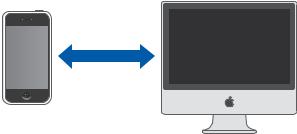
Syncing iPhone with Your Computer
When you connect iPhone to your computer, iTunes syncs iPhone with the information and media on your computer, according to how you’ve configured the iPhone sync settings in iTunes.
You can set iTunes to sync any or all of the following:
ÂContacts—names, phone numbers, addresses, email addresses, and so on
ÂCalendars—appointments and events
ÂEmail account settings
ÂWebpage bookmarks
ÂRingtones
ÂMusic and audiobooks
ÂPhotos
ÂPodcasts
ÂVideos
Ringtones, music, audiobooks, podcasts, and video content are synced from your iTunes library. If you don’t already have content in iTunes, the iTunes Store (available in some countries) makes it easy to purchase or subscribe to content and download it to iTunes. You can also add music to your iTunes library from your CDs. To learn about iTunes and the iTunes Store, open iTunes and choose Help > iTunes Help.
Contacts, calendars, webpage bookmarks, and photos are synced from applications on your computer, as described below. Contacts and calendars are synced both ways between your computer and iPhone. New entries or changes you make on iPhone are synced to your computer, and vice versa. Webpage bookmarks are also synced both ways.
Email account settings are only synced from your computer’s email application to iPhone. This allows you to customize your email accounts on iPhone without affecting email account settings on your computer.
Chapter 1 Activating and Setting Up iPhone |
7 |
|
|
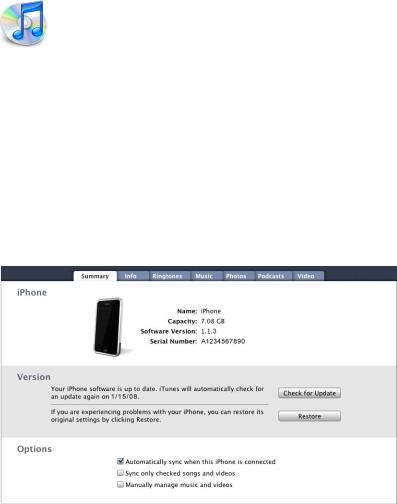
If you like, you can set iPhone to sync with only a portion of what’s on your computer. For example, you might want to sync only a group of contacts from your address book, or only unwatched video podcasts. You can adjust sync settings whenever iPhone is connected to your computer.
Important: You can connect and sync with only one iPhone at a time. Disconnect one before connecting another. You should be logged in to your own user account on the computer before connecting iPhone. On a PC, if you sync more than one iPhone to the same user account, use the same sync settings for each.
Setting Up Syncing
You use the iPhone settings panes in iTunes to specify the iTunes content and other information you want to sync to iPhone.
Set up syncing
1 Connect iPhone to your computer, and open iTunes (if it doesn’t open automatically).
Unless your keyboard has a high-powered USB 2.0 port, you must connect iPhone to a USB 2.0 port on your computer.
2 Select iPhone in the iTunes window (below Devices, on the left).
3 Configure the sync settings in each of the settings panes.
4Click Apply in the lower-right corner of the screen.
The following sections provide an overview of each of the iPhone settings panes. For more information, open iTunes and choose Help > iTunes Help.
8 |
Chapter 1 Activating and Setting Up iPhone |
|
|
Summary Pane
Select “Automatically sync when this iPhone is connected” to have iTunes sync iPhone automatically whenever you connect it to your computer. Deselect this option if you want to sync only by clicking the Sync button in iTunes. For more information about preventing automatic syncing, see page 11.
Select “Sync only checked songs and videos” if you want to sync only items that are individually checked in your iTunes library.
Select “Manually manage music and videos” to turn off syncing in the Music and Video settings panes.
Info Pane
The Info pane lets you configure the sync settings for your contacts, calendars, email accounts, and web browser.
Contacts
You can sync contacts with applications such as Mac OS X Address Book, Microsoft Entourage, and Yahoo! Address Book on a Mac, or with Yahoo! Address Book, Windows Address Book (Outlook Express), or Microsoft Outlook 2003 or 2007 on a PC. (On a Mac, you can sync contacts with multiple applications. On a PC, you can sync contacts with only one application at a time.)
If you sync with Yahoo! Address Book, you only need to click Configure to enter your new login information when you change your Yahoo! ID or password after you’ve set up syncing.
Note: Syncing won’t delete any contact in Yahoo! Address Book that contains a Messenger ID, even if you’ve deleted the contact from your address book on iPhone or your computer. To delete a contact containing a Messenger ID, log in to your Yahoo! account and delete the contact using Yahoo! Address Book online.
Calendars
You can sync calendars from applications such as iCal and Microsoft Entourage on a Mac, or from Microsoft Outlook 2003 or 2007 on a PC. (On a Mac, you can sync calendars with multiple applications. On a PC, you can sync calendars with only one application at a time.)
Chapter 1 Activating and Setting Up iPhone |
9 |
|
|
Mail Accounts
You can sync email account settings from Mail on a Mac, and from Microsoft Outlook 2003 or 2007 or Outlook Express on a PC. Account settings are only transferred from your computer to iPhone. Changes you make to an email account on iPhone don’t affect the account on your computer.
Note: The password for your Yahoo! email account isn’t saved on your computer.
If you sync a Yahoo! email account, you must enter the password on iPhone. From the Home screen choose Settings > Mail, choose your Yahoo! account, then enter your password in the password field.
Web Browser
You can sync bookmarks from Safari on a Mac, or from Safari or Microsoft Internet Explorer on a PC.
Advanced
These options let you replace the information on iPhone with the information on your computer during the next sync.
Ringtones
Use the Ringtones pane to select the ringtones you want to sync to iPhone.
Music, Podcasts, and Video Panes
Use these panes to specify the media you want to sync. You can sync all music, podcasts, and videos, or select the playlists and specific podcasts and videos you want on iPhone. Audiobooks and music videos are synced along with music.
If you want to watch rented movies on iPhone, transfer them to iPhone using the Video pane in iTunes.
If there’s not enough room on iPhone for all the media you’ve specified, iTunes asks if you want to create a special playlist and set it to sync with iPhone. Then iTunes randomly fills the playlist.
Photos Pane
You can sync photos with iPhoto 4.0.3 or later on a Mac, or with Adobe Photoshop Album 2.0 or later or Adobe Photoshop Elements 3.0 or later on a PC. You can also sync photos in any folder on your computer that contains images.
10 |
Chapter 1 Activating and Setting Up iPhone |
|
|
Preventing iPhone from Syncing Automatically
You may want to prevent iPhone from syncing automatically when you connect iPhone to a computer other than the one you usually sync with.
Turn off automatic syncing for iPhone
mConnect iPhone to your computer, then select iPhone in the iTunes source list (below Devices, on the left) and click the Summary tab. Deselect “Automatically sync when this iPhone is connected.”You can still sync manually by clicking the Sync button.
Prevent automatic syncing for all iPhones
mIn iTunes choose iTunes > Preferences (on a Mac) or Edit > Preferences (on a PC), click iPhone, and select “Disable automatic syncing for all iPhones.”
If this checkbox is selected, iPhone won’t sync automatically, even if “Automatically sync when this iPhone is connected” is selected in the Summary pane.
Prevent automatic syncing one time, without changing any settings
mOpen iTunes. Then, as you connect iPhone to your computer, press and hold Command-Option (on a Mac) or Shift-Control (on a PC) until you see iPhone in the iTunes source list (below Devices, on the left).
Sync manually
mSelect iPhone in the iTunes source list (below Devices, on the left), then click Sync in the lower-right corner of the window. Or, if you’ve changed any sync settings, click Apply.
Disconnecting iPhone from Your Computer
Unless iPhone is syncing with your computer, you can disconnect if from your computer at any time.
When iPhone is syncing with your computer, iPhone shows “Sync in progress.” If you disconnect iPhone before it finishes syncing, some data may not get transferred. When iPhone finishes syncing, iTunes shows “iPhone sync is complete.”
To cancel a sync so you can disconnect iPhone, drag the slider on iPhone. If you get a call during a sync, the sync is canceled automatically and you can unplug iPhone to answer the call. Connect iPhone after the call to finish syncing.
Chapter 1 Activating and Setting Up iPhone |
11 |
|
|
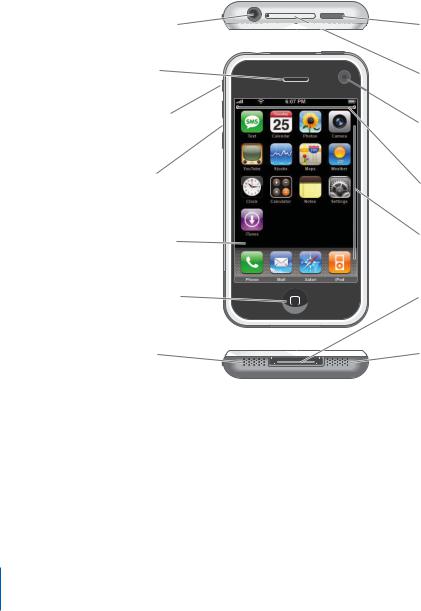
2 |
Basics |
2 |
|
||
|
|
|
iPhone at a Glance
Headset jack |
Sleep/Wake |
|
|
button |
|
Receiver |
SIM card tray |
|
|
||
Ring/Silent |
Camera |
|
switch |
||
(on back) |
||
|
||
Volume |
|
|
buttons |
Status bar |
|
Touchscreen |
Application |
|
icons |
||
|
||
Home button |
Dock connector |
|
Speaker |
Microphone |
12
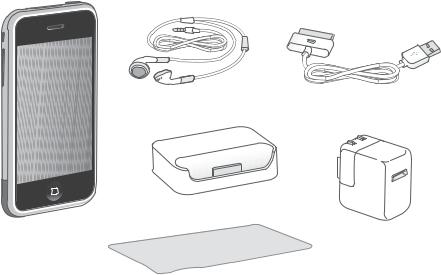
Stereo headset
Dock
hone Pi
Dock connector to USB cable
USB power adapter
|
Polishing cloth |
|
|
Item |
What you can do with it |
|
|
Stereo headset |
Listen to music, videos, and phone calls. Use the built-in microphone to talk. |
|
Click the mic button to answer or end a call. When listening to iPod, click |
|
the button once to play or pause a song, or click twice quickly to skip to the |
|
next track. |
|
|
Dock |
Connect the dock to your computer or to the power adapter using the |
|
included cable, then set iPhone in the dock so it stands upright as it charges |
|
or syncs. |
|
Connect external speakers to the line out port on the back of the dock |
|
using an audio cable that has a standard 3.5 millimeter stereo miniplug. |
|
|
Dock connector to USB |
Use the cable to connect iPhone to your computer to sync and charge, |
cable |
or to the power adapter to charge. The cable can be used with the dock or |
|
plugged directly into iPhone. |
|
|
USB power adapter |
Connect the power adapter to iPhone using the included cable, then plug it |
|
into a standard power outlet to charge iPhone. |
|
|
Polishing cloth |
Wipe the iPhone screen. |
|
|
SIM eject tool |
Eject the SIM card (tool not included with iPhone in all countries). |
|
|
Chapter 2 Basics |
13 |
|
|
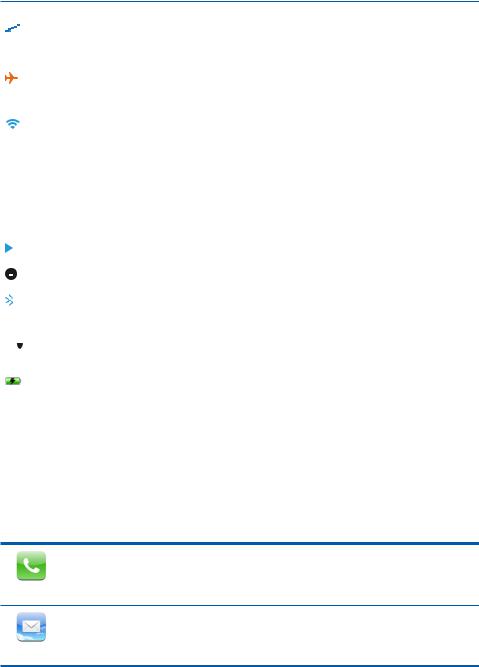
Status Icons
The icons in the status bar at the top of the screen give information about iPhone:
Status icon |
What it means |
||||||
|
|
|
|
|
|
Cell signal |
Shows whether you’re in range of the cell network and can make |
|
|
|
|
|
|||
|
|
|
|||||
|
|
||||||
|
|
|
|
||||
|
|
|
|
|
|
|
and receive calls. The more bars, the stronger the signal. If there’s |
|
|
|
|
|
|
|
no signal, the bars are replaced with “No service.” |
|
|
|
|
|
|
|
|
|
|
|
|
|
|
Airplane Mode |
Shows that airplane mode is on—you cannot use the phone, |
|
|
|
|
|
|
|
access the Internet, or use Bluetooth® devices. Non-wireless |
|
|
|
|
|
|
|
features are available. See page 91. |
|
|
|
|
|
|
|
|
|
|
|
|
|
|
Wi-Fi |
Shows that iPhone is connected to the Internet over a Wi-Fi |
|
|
|
|
|
|
|
network. The more bars, the stronger the connection. See page 24. |
|
|
|
|
|
|
|
|
|
|
|
|
|
|
EDGE |
Shows that your carrier’s EDGE network is available, and iPhone can |
|
|
|
|
|
|||
|
|
|
|
|
|
|
connect to the Internet over EDGE. See page 25. |
|
|
|
|
|
|
|
|
|
|
|
|
|
|
GPRS |
Shows that your carrier’s GPRS network is available, and iPhone can |
|
|
|
|
|
|||
|
|
|
|
|
|
|
connect to the Internet over GPRS. See page 25. |
|
|
|
|
|
|
|
|
¥ |
|
|
|
|
Lock |
Shows that iPhone is locked. See page 17. |
|
|
|
|
|
|
|
|
|
|
|
|
|
|
|
Play |
Shows that a song is playing. See page 60. |
|
|
|
|
|
|
|
|
|
|
|
|
|
|
Alarm |
Shows that an alarm is set. See page 87. |
|
|
|
|
|
|||
|
|
|
|
|
|||
|
|
|
|
|
|
|
|
|
|
|
|
|
|
Bluetooth |
Blue or white icon: Bluetooth is on and a device, such as a headset |
|
|
|
|
|
|
|
or car kit, is connected. Gray icon: Bluetooth is on, but no device is |
|
|
|
|
|
|
|
connected. No icon: Bluetooth is turned off. See page 41. |
|
|
|
|
|
|
|
|
|
|
|
|
|
|
Bluetooth Headset |
Shows battery level for the iPhone Bluetooth Headset when it’s |
|
|
|
|
|
|
battery indicator |
connected. |
|
|
|
|
|
|
|
|
|
|
|
|
|
|
Battery |
Shows battery level or charging status. See page 27. |
|
|
|
|
|
|
|
|
Home Screen
Press the Home button at any time to see your iPhone applications. Tap any application icon to get started.
button at any time to see your iPhone applications. Tap any application icon to get started.
iPhone Applications
The following applications are included with iPhone:
Make calls, with quick access to recent callers, favorites, and all your contacts. Visual voicemail presents a list of your voicemail messages. Just tap to listen to any message
you want, in any order you want.
Phone
Send and receive email using your existing email accounts. iPhone works with the most popular email systems—including Yahoo! Mail, Google email, AOL, and .Mac
Mail—as well as most industry-standard POP3 and IMAP email systems.
14 |
Chapter 2 Basics |
|
|
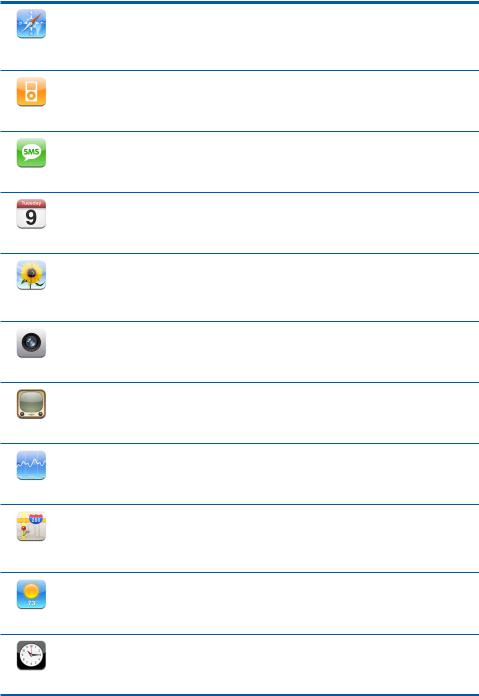
Browse any website over a cellular data network or over Wi-Fi. Rotate iPhone sideways for widescreen viewing. Double-tap to zoom in or out—Safari automatically fits
Safari
sections to the iPhone screen for easy reading. Add Safari Web Clips to the Home screen for fast access to favorite websites.
Listen to your songs, audiobooks, and podcasts. Watch movies and video podcasts in widescreen.
iPod
Send and receive SMS text messages with anyone who has an SMS-capable phone. Conversations are saved in an iChat-like presentation, so you can see a history of
messages you’ve sent and received.
Text
View your iCal, Microsoft Entourage, or Microsoft Outlook calendar synced from your computer. Enter events on iPhone and they get synced back to your computer.
Set alerts to remind you of events, appointments, and deadlines.
Calendar
View photos transferred from your computer or taken with iPhone. View them in portrait or landscape mode. Zoom in on any photo for a closer look. Watch a
Photos
slideshow. Email photos, add them to a Web Gallery, assign them to contacts, and use them as wallpaper.
Take clear, crisp photos at two megapixels and view them on iPhone, email them, or upload them to your computer. Take a friend’s picture and set iPhone to display it
when that person calls you.
Camera
Play videos from YouTube’s online collection.1 Search for any video, or browse featured, most viewed, most recently updated, and top-rated videos.
YouTube
Watch your favorite stocks, updated automatically from the Internet.
Stocks
See a street map, satellite view, or hybrid view of locations around the world. Zoom in for a closer look. Find your current approximate location. Get detailed driving
Maps
directions and see current highway traffic conditions. Find businesses in the area and call with a single tap.2
Get current weather conditions and a six-day forecast. Store your favorite cities for a quick weather report anytime.
Weather
View the time in cities around the world—create clocks for your favorites. Set one or more alarms. Use the stopwatch, or set a countdown timer.
Clock
Chapter 2 Basics |
15 |
|
|

Add, subtract, multiply, and divide.
Calculator
Jot notes on the go—reminders, grocery lists, brilliant ideas. Send them in email.
Notes
Adjust all iPhone settings in one convenient place. Set your ringtone, wallpaper, screen brightness, and settings for network, phone, mail, web, music, video, photos,
and more. Set auto-lock and a passcode for security.
Settings
Search the iTunes Wi-Fi Music Store music catalog, or browse, preview, and purchase new releases, top-ten songs and albums, and more.3 In select Starbucks locations,4 find
iTunes
out what song is playing in the café, then buy it instantly. Browse, preview, and purchase other songs from featured Starbucks Collections.
1 Not available in all areas.
2 Some features or services not available in all areas. 3 Not available in all areas.
4 In the U.S. only.
Customizing the Home Screen Layout
You can customize the layout of icons on the Home screen—including the Dock icons along the bottom of the screen. If you want, arrange them over multiple Home screens.
Rearrange icons
1 Touch and hold any Home screen icon until all of the icons begin to wiggle.
2 Arrange the icons by dragging them.
3Press the Home button to save your arrangement.
button to save your arrangement.
You can also add links to your favorite webpages on the Home screen. See “Adding Safari Web Clips to the Home Screen” on page 56.
16 |
Chapter 2 Basics |
|
|
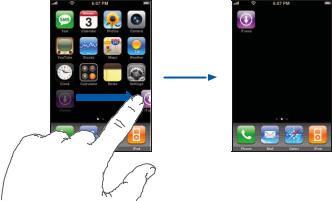
Create additional Home screens
mWhile arranging icons, drag an icon to the right edge of the screen until a new screen appears. You can flick to return to the original screen and drag more icons to the new screen.
You can create up to nine screens. The number of dots at the bottom shows the number of screens you have, and indicates which screen you are viewing.
Switch to another Home screen
mFlick left or right.
Reset your Home screen to the default layout
mChoose Settings > General > Reset and tap Reset Home Screen Layout.
iPhone Buttons and Touchscreen
A few simple buttons and a high-resolution touchscreen make it easy to learn and use iPhone.
Locking iPhone and Turning It On or Off
When you’re not using iPhone but you still want to receive calls and text messages, you can lock it.
When iPhone is locked, nothing happens if you touch the screen. You can still listen to music and adjust the volume, and use the button on the included stereo headset to play or pause a song, or answer or end a call.
Chapter 2 Basics |
17 |
|
|
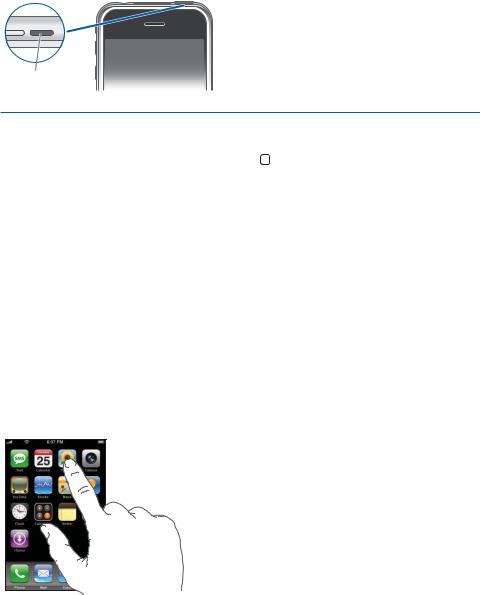
By default, if you don’t touch the screen for a minute, iPhone locks automatically.
Sleep/Wake
button
To |
Do this |
|
Lock iPhone |
Press the Sleep/Wake button. |
|
|
|
|
Unlock iPhone |
Press the Home |
button or the Sleep/Wake button, then |
|
drag the slider. |
|
|
|
|
Turn iPhone completely off |
Press and hold the Sleep/Wake button for a few seconds until |
|
|
the red slider appears, then drag the slider. |
|
|
When iPhone is off, incoming calls go straight to voicemail. |
|
|
|
|
Turn iPhone on |
Press and hold the Sleep/Wake button until the Apple logo |
|
|
appears. |
|
|
|
|
For information about changing the time before iPhone locks, see “Auto-Lock” on page 97. For information about setting iPhone to require a passcode to unlock it, see “Passcode Lock” on page 97.
Using the Touchscreen
The controls on the iPhone touchscreen change dynamically depending on the task you are performing.
m Tap any application to open it.
m Press the Home  button below the display at any time to return to the Home screen.
button below the display at any time to return to the Home screen.
18 |
Chapter 2 Basics |
|
|
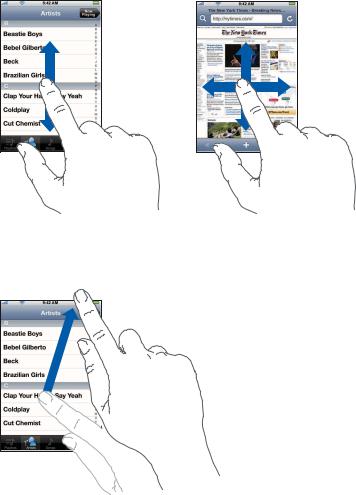
mDrag up or down to scroll. On some screens such as webpages, you can also scroll side to side.
Dragging your finger to scroll won’t choose or activate anything on the screen.
m Flick to scroll quickly.
You can wait for the scrolling to come to a stop, or tap or touch anywhere on the screen to stop it immediately. Tapping or touching to stop scrolling won’t choose or activate anything on the screen.
Chapter 2 Basics |
19 |
|
|
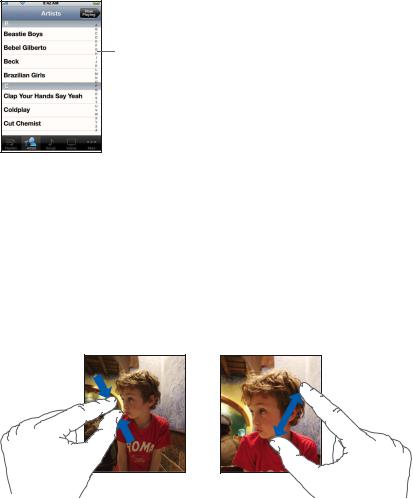
mSome lists have an index along the right side. Tap a letter to jump to items starting with that letter. Drag your finger along the index to scroll quickly through the list.
Index
mTap an item in the list to choose it. Depending on the list, tapping an item can do different things—for example, it may open a new list, play a song, open an email, or show someone’s contact information so you can call that person.
mThe back button in the upper-left corner shows the name of the previous list. Tap it to go back.
mWhen viewing photos, web pages, email, or maps, you can zoom in and out. Pinch your fingers together or apart. For photos and web pages, you can double-tap (tap twice quickly) to zoom in, then double-tap again to zoom out. For maps, double-tap to zoom in and tap once with two fingers to zoom out.
Onscreen Keyboard
Use the onscreen keyboard to enter text, such as contact information, text messages, or URLs. Depending on the application you’re using, the intelligent keyboard may automatically suggest corrections as you type (some languages only), to help prevent mistyped words.
iPhone provides keyboards in multiple languages, and supports the following keyboard formats:
ÂQWERTY
ÂQWERTZ
20 |
Chapter 2 Basics |
|
|
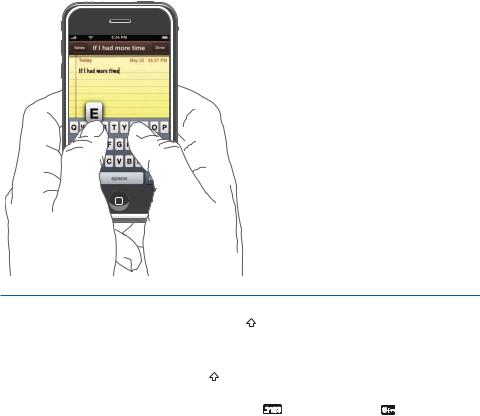
ÂAZERTY
ÂQZERTY
ÂJapanese IME
See “Keyboard” on page 98 for information about turning on keyboards for different languages and other keyboard settings.
Entering Text
Start by typing with just your index finger. As you get more proficient, you can type more quickly using two thumbs.
1 Tap a text field, such as in a note or new contact, to bring up the keyboard.
2Tap keys on the keyboard.
As you type, each letter appears above your thumb or finger. If you touch the wrong key, you can slide your finger to the correct key. The letter is not entered until you release your finger from the key.
To |
Do this |
|
|
|
Type uppercase |
Tap the Shift |
key before tapping a letter. |
|
|
|
|
|
||
Quickly type a period and space |
Double-tap the space bar. |
|
||
|
|
|||
Turn caps lock on |
Enable caps lock (see page 98), then double-tap the |
|||
|
Shift |
key. The Shift key turns blue, and all letters you type |
||
|
are uppercase. Tap the Shift key again to turn caps lock off. |
|||
|
|
|
|
|
Shows numbers, punctuation, |
Tap the Number |
key. Tap the Symbol |
key to see |
|
or symbols |
additional punctuation and symbols. |
|
||
|
|
|
|
|
Chapter 2 Basics |
21 |
|
|
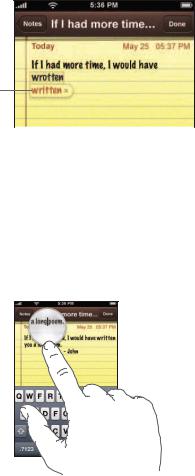
Accepting or Rejecting Dictionary Suggestions
iPhone has dictionaries for English, English (UK), French, German, and Italian. The appropriate dictionary is activated automatically when you select a keyboard on iPhone. iPhone uses the active dictionary to suggest corrections or complete the word you’re typing.
Suggested word
You don’t need to interrupt your typing to accept the suggested word.
ÂTo use the suggested word, type a space, punctuation mark, or return character.
ÂTo reject the suggested word, finish typing the word as you want it, then tap the “x” to dismiss the suggestion before typing anything else. Each time you reject a suggestion for the same word, iPhone becomes more likely to accept your word.
Editing text
m Touch and hold to see a magnified view, then drag to position the insertion point.
22 |
Chapter 2 Basics |
|
|
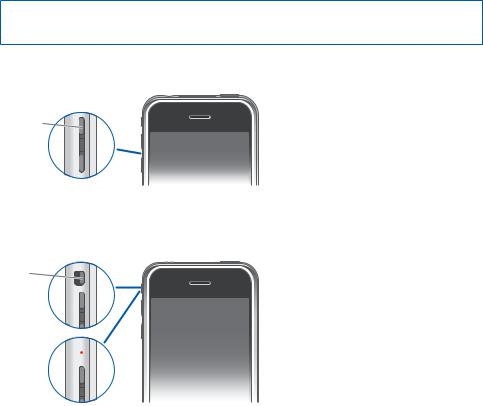
Adjusting the Volume
When you’re on the phone or listening to songs, movies, or other media, the buttons on the side of iPhone adjust the audio volume. Otherwise, the buttons control the volume for the ringer, alerts, and other sound effects.
WARNING: For important information about avoiding hearing loss, see the Important Product Information Guide at www.apple.com/support/manuals/iphone.
m To adjust the volume, use the buttons on the side of iPhone.
Volume up
Volume  down
down 
To set a volume limit for music and videos on iPhone, see page 105.
m Flip the Ring/Silent switch to change between ring  and silent
and silent  modes.
modes.
Ring
Silent 
When set to ring mode, iPhone plays all sounds. When set to silent mode, iPhone doesn’t ring or sound any alerts or sound effects. Alarms set using Clock do sound, however. By default, when you get a call, iPhone vibrates whether it’s set to ring or silent mode. If iPhone is set to ring mode, you can silence a call by pressing the Sleep/
Wake button or one of the volume buttons once. Press a second time to send the call to voicemail.
For information about changing sound and vibrate settings, see page 93.
Using the Stereo Headset
The headset included with iPhone features a microphone and an integrated button that allows you to answer and end calls easily, and control audio and video playback.
Chapter 2 Basics |
23 |
|
|
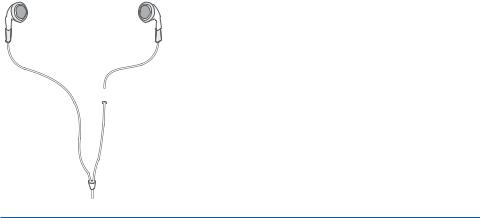
Plug in the headset to listen to music or a phone call. Callers hear you through the headset microphone. Click the mic button to control music playback and answer or end calls, even when iPhone is locked.

 Mic button
Mic button
To |
Do this |
Pause a song or video |
Click the mic button once. Click again to resume playback. |
|
|
Skip to the next song |
Click twice quickly. |
|
|
Answer an incoming call |
Click once. |
|
|
End the current call |
Click once. |
|
|
Decline an incoming call |
Press and hold for about two seconds, then let go. When you |
|
let go, two low beeps confirm you declined the call. |
|
|
Switch to an incoming or on-hold |
Click once. Click again to switch back to the first call. |
call and put the current call on hold |
|
|
|
Switch to an incoming or on-hold |
Press and hold for about two seconds, then let go. When you |
call and end the current call |
let go, two low beeps confirm you ended the first call. |
|
|
If you get a call while the headset is plugged in, you can hear the ringtone through both the iPhone speaker and the headset.
Connecting to the Internet
iPhone connects to the Internet automatically whenever you use Mail, Safari, YouTube, Stocks, Maps, Weather, or the iTunes Wi-Fi Music Store. iPhone does the following, in order, until connected:
ÂConnects over the last Wi-Fi  network you used that’s available.
network you used that’s available.
ÂIf no previously used Wi-Fi networks are available, iPhone shows a list of Wi-Fi networks in range. Tap a network and, if necessary, enter the password to join. Networks that require a password show ¥ next to them. You can prevent iPhone from automatically showing available networks. See “Set iPhone to ask if you want to join a new network” on page 92.
24 |
Chapter 2 Basics |
|
|
ÂIf no Wi-Fi networks are available or you choose not to join any, iPhone connects to the Internet over a cellular data network ( or
or  ). You cannot access the iTunes WiFi Music Store over a cellular network.
). You cannot access the iTunes WiFi Music Store over a cellular network.
If no Wi-Fi networks are available and a cellular data network is not available, iPhone cannot connect to the Internet. Turning on airplane mode disables both Wi-Fi and cellular network access.
Note: Because iPhone uses the cellular network for the phone, you cannot use the Internet over a cellular network when you’re on a call. To talk on the phone and use Internet applications at the same time, connect over a Wi-Fi network.
Many Wi-Fi networks can be used free of charge including, in some regions, Wi-Fi hotspots provided by your iPhone carrier. Some Wi-Fi networks require a fee. To join a Wi-Fi network at a hotspot where charges apply, you can usually open Safari to see a webpage that allows you to sign up for service.
Joining a Wi-Fi Network
The Wi-Fi settings let you turn on Wi-Fi and join Wi-Fi networks.
Turn on Wi-Fi
mChoose Settings > Wi-Fi and turn Wi-Fi on.
Join a Wi-Fi network
mChoose Settings > Wi-Fi, wait a moment as iPhone detects networks in range, then select a network. If necessary, enter a password and tap Join (networks that require a password appear with a lock icon).
Once you’ve joined a Wi-Fi network manually, iPhone will automatically connect to it whenever the network is in range. If more than one previously used network is in range, iPhone joins the one last used.
When iPhone is connected to a Wi-Fi network, the Wi-Fi icon  in the status bar at the top of the screen shows connection strength. The more bars you see, the stronger the connection.
in the status bar at the top of the screen shows connection strength. The more bars you see, the stronger the connection.
For information about configuring Wi-Fi settings, see “Wi-Fi” on page 92.
Accessing the Internet via Cellular Network
EDGE and GPRS allow Internet connectivity over the cellular network available through your iPhone carrier’s wireless service. Check the carrier’s network coverage in your area for availability.
While iPhone is actively transferring data over a cellular network—downloading a webpage, for example—you may not be able to receive calls. Incoming calls then go directly to voicemail.
Chapter 2 Basics |
25 |
|
|
You can tell iPhone is connected to the Internet over EDGE if you see  in the status bar at the top of the screen. If iPhone is connected to the Internet over GPRS,
in the status bar at the top of the screen. If iPhone is connected to the Internet over GPRS,  appears in the status bar.
appears in the status bar.
If you’re outside your carrier’s network, you may be able to access the Internet from another carrier. To enable email, web browsing, and other data services whenever possible, turn Data Roaming on.
mIn Settings, choose General > Network and turn Data Roaming on.
Note: Roaming charges may apply. To avoid roaming charges, make sure Data Roaming is turned off.
Using iPhone on an Airplane
Airplane mode disables the wireless features of iPhone to avoid interfering with aircraft operation and other electrical equipment.
mFrom the Home screen choose Settings, then turn airplane mode on.
When you turn on airplane mode,  appears in the status bar at the top of the screen. No cell phone, radio, Wi-Fi, or Bluetooth signals are emitted from iPhone. You cannot:
appears in the status bar at the top of the screen. No cell phone, radio, Wi-Fi, or Bluetooth signals are emitted from iPhone. You cannot:
ÂMake phone calls
ÂSend or receive email
ÂBrowse the Internet
ÂSend or receive text messages
ÂStream YouTube videos
ÂGet stock quotes
ÂGet maps locations
ÂGet weather reports
If allowed by the aircraft operator and applicable laws and regulations, you can continue to use iPhone to:
ÂListen to music and watch video
ÂListen to visual voicemail
ÂCheck your calendar
ÂTake or view pictures
ÂHear alarms
ÂUse the stopwatch or timer
ÂUse the calculator
ÂTake notes
ÂRead text messages and email messages stored on iPhone
26 |
Chapter 2 Basics |
|
|
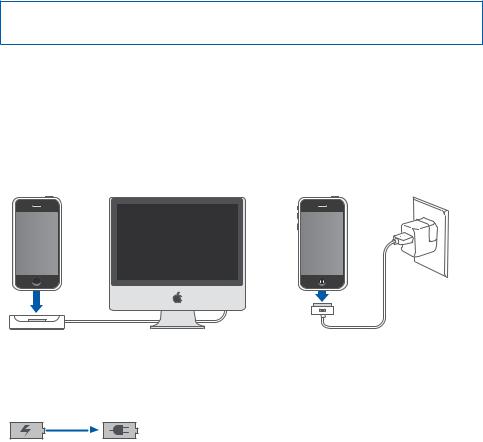
Charging the Battery
iPhone has an internal rechargeable battery.
WARNING: For important safety information about charging iPhone, see the Important Product Information Guide at www.apple.com/support/manuals/iphone.
Charge the battery
mConnect iPhone to a power outlet using the included cable and power adapter.
Charge the battery and sync iPhone
mConnect iPhone to your computer using the included cable and dock.
Unless your keyboard has a high-powered USB 2.0 port, you must connect iPhone to a USB 2.0 port on your computer.
Note: If iPhone is connected to a computer that’s turned off or is in sleep or standby mode, the iPhone battery may drain.
An icon in the upper-right corner of the screen shows battery charging status.
Charging Charged
If you charge the battery while syncing or using iPhone, it may take longer to charge.
Chapter 2 Basics |
27 |
|
|
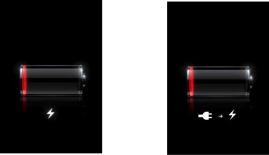
Important: If iPhone is very low on power, it may display one of the following images indicating that iPhone needs to charge for up to ten minutes before you can use it. If iPhone is extremely low on power, the display may be blank for up to two minutes before one of the low-battery images appears.
or
Rechargeable batteries have a limited number of charge cycles and may eventually need to be replaced. The iPhone battery is not user replaceable; it can only be replaced by an authorized service provider. For more information, go to: www.apple.com/batteries
Cleaning iPhone
Use the polishing cloth that came with iPhone to gently wipe the glass screen and the case.
You can also use a soft, slightly damp, lint-free cloth. Unplug and turn off iPhone (press and hold the Sleep/Wake button, then drag the onscreen red slider). Avoid getting moisture in openings. Don’t use window cleaners, household cleaners, aerosol sprays, solvents, alcohol, ammonia, or abrasives to clean iPhone.
28 |
Chapter 2 Basics |
|
|

3 |
Phone |
3 |
|
||
|
|
|
Tap Phone to make calls, view and add contacts, and check voicemail.
Making a call on iPhone is as simple as tapping a name or number in your contacts list or tapping a contact in your favorites list. Or tap the name of a recent caller to return the call. If you’ve set up iTunes to sync contacts automatically, your contacts are synced with the address book on your computer each time you connect iPhone.
Visual voicemail displays a list of your voicemail messages so you can listen to them in whatever order you chose. Or tap to get more information, such as the time and duration of the call. (Visual voicemail may not be available in all regions.)
Calling and Answering
The cell signal indicator 



 at the top of the screen shows whether you’re in range of the cell network and can make and receive calls. The more bars, the stronger the signal.
at the top of the screen shows whether you’re in range of the cell network and can make and receive calls. The more bars, the stronger the signal.
WARNING: For important information about driving safely, see the Important Product Information Guide at www.apple.com/support/manuals/iphone.
Making a Call
Making a call is easy—simply tap an entry in your list of contacts, favorites, or recent calls on iPhone. Or you can make a call the “old-fashioned” way, by entering a number on the keypad.
Call someone in your contacts list
mTap Contacts and choose a contact, then tap the phone number you want to call.
Call someone in your favorites list
mTap Favorites and choose a contact.
29
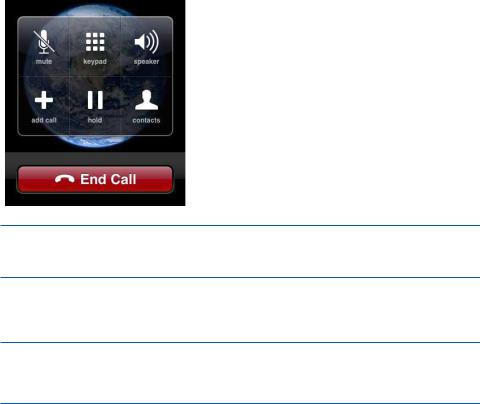
You can double-click the Home button to quickly go to Favorites. See “Home Button” on page 95.
For information about adding people to your favorites list, see page 39.
Call someone you’ve recently called or who has recently called you
mTap Recents and choose a person or number. Calls you’ve missed are shown in red. Tap Missed to see only missed calls.
Dial a call
mTap Keypad and enter the number, then tap Call. Tap  if you make a mistake.
if you make a mistake.
You can also tap Keypad and then tap Call, to bring up the number of the last number you dialed.
While You’re On a Call
When you’re on a call, the screen shows call options.
Call options
To |
Do this |
Mute the microphone |
Tap Mute. The caller can’t hear you, but you can still hear the |
|
caller. Tap Mute again for the caller to hear you. |
Use the keypad to enter information
Tap Keypad.
You can use the keypad to enter information requested by automated voice systems, such as when calling airlines reservations. Tap Hide Keypad to see call options again.
Use the speakerphone or a Bluetooth device, so you can talk and listen hands-free
Tap Speaker anytime you’re on a call. If iPhone is paired with an active Bluetooth headset or car kit, the button is labeled Audio Source and lets you select the Bluetooth device, iPhone, or Speaker Phone.
Make a conference call |
Tap Add Call. For information about conference calling, see |
|
page 33. |
|
|
Put a call on hold |
Tap Hold. The caller can’t hear you and you can’t hear the caller. |
|
Tap Hold again to talk again. |
|
|
30 |
Chapter 3 Phone |
|
|
